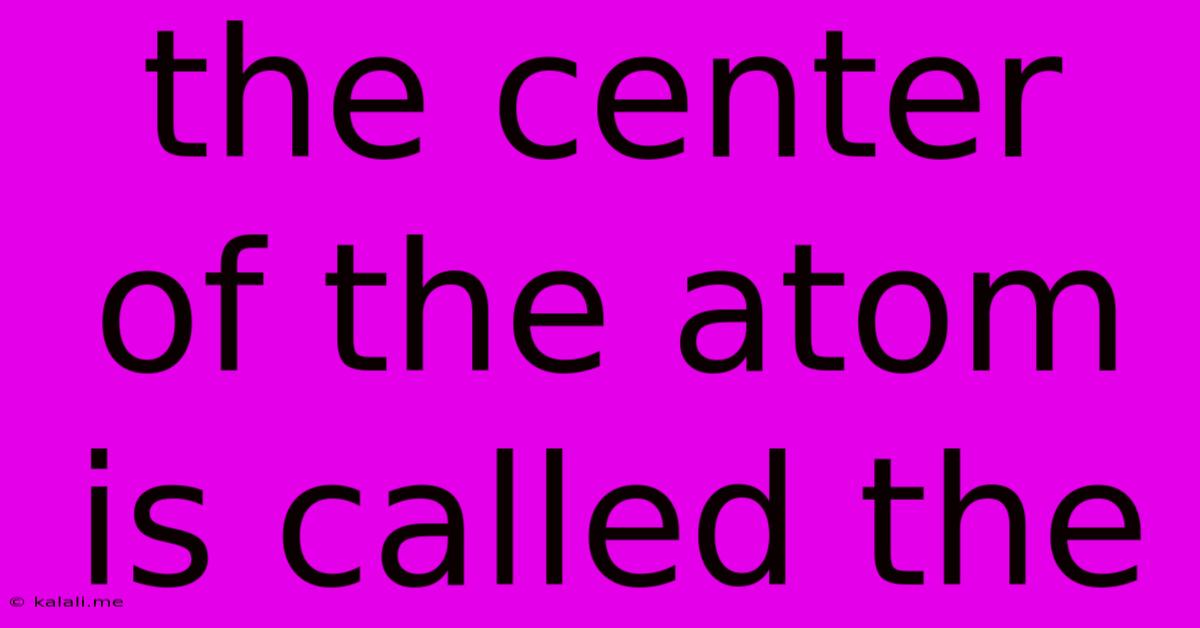The Center Of The Atom Is Called The
Kalali
May 09, 2025 · 3 min read

Table of Contents
The Center of the Atom is Called the Nucleus: A Deep Dive into Atomic Structure
The center of the atom is called the nucleus. This seemingly simple answer belies a complex and fascinating world of subatomic particles and fundamental forces that govern the behavior of all matter. Understanding the nucleus is key to understanding chemistry, physics, and the very fabric of our universe. This article will delve into the structure and properties of the atomic nucleus, exploring its composition and its crucial role in determining the properties of elements.
The nucleus is incredibly small, occupying only a tiny fraction of the atom's overall volume. Yet, it contains almost all of the atom's mass, packed tightly together. This dense concentration of mass is responsible for many of the atom's properties, including its radioactivity and its ability to participate in nuclear reactions.
What Makes Up the Nucleus?
The nucleus is primarily composed of two types of subatomic particles:
- Protons: These particles carry a positive electrical charge and contribute to the atom's atomic number. The atomic number uniquely identifies an element; for example, hydrogen has one proton, helium has two, and so on.
- Neutrons: These particles carry no electrical charge (they are neutral) and contribute to the atom's mass number. The mass number is the total number of protons and neutrons in the nucleus.
The number of protons determines the element, while the number of neutrons can vary within an element, leading to different isotopes. Isotopes are atoms of the same element with the same number of protons but different numbers of neutrons. Some isotopes are stable, while others are radioactive, meaning they spontaneously decay over time, emitting particles and energy.
The Strong Nuclear Force: Holding it All Together
Given that protons are positively charged and like charges repel, it might seem puzzling how the nucleus can remain stable. The answer lies in the strong nuclear force, one of the four fundamental forces in nature. This force is much stronger than the electromagnetic force (which causes the repulsion between protons) at very short distances, effectively overcoming the electrostatic repulsion and binding the protons and neutrons together within the nucleus.
Importance of the Nucleus: Beyond Atomic Structure
The nucleus plays a crucial role in various fields:
- Nuclear Physics: The study of the nucleus and its properties is crucial for understanding nuclear reactions, such as fission and fusion, which are harnessed in nuclear power plants and nuclear weapons.
- Radioactive Dating: Radioactive isotopes with known decay rates are used to determine the age of materials, artifacts, and even the Earth itself.
- Medical Applications: Radioactive isotopes are used in medical imaging techniques like PET scans and in cancer treatments like radiotherapy.
- Nuclear Chemistry: Understanding nuclear structure is essential for predicting the behavior of elements in chemical reactions, particularly those involving radioactive materials.
In conclusion, the nucleus, the dense central core of the atom, is far more than just the atom's center. It's a dynamic and complex structure, a microcosm of fundamental forces and interactions that govern the world around us. Its composition and properties are fundamental to understanding the behavior of matter at both the atomic and macroscopic levels. Further exploration into nuclear physics reveals ever-increasing levels of complexity and opens avenues for groundbreaking scientific advancements.
Latest Posts
Latest Posts
-
How Much Is 5 Oz In Grams
May 09, 2025
-
Median In A Stem And Leaf Plot
May 09, 2025
-
What Percent Of 80 Is 100
May 09, 2025
-
How Much Is 24 Inches In Centimeters
May 09, 2025
-
Cuanto Es 51 Cm En Pulgadas
May 09, 2025
Related Post
Thank you for visiting our website which covers about The Center Of The Atom Is Called The . We hope the information provided has been useful to you. Feel free to contact us if you have any questions or need further assistance. See you next time and don't miss to bookmark.